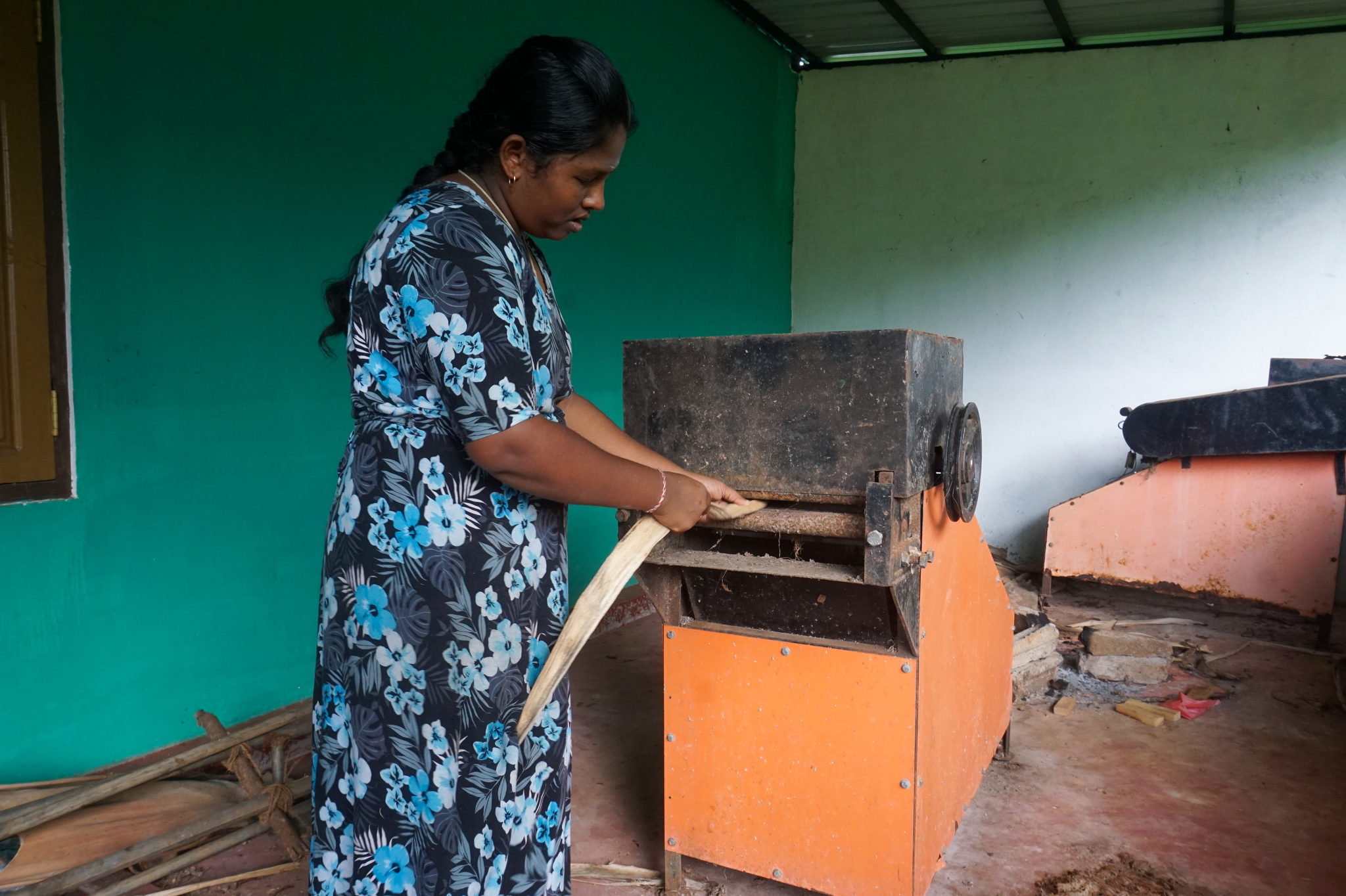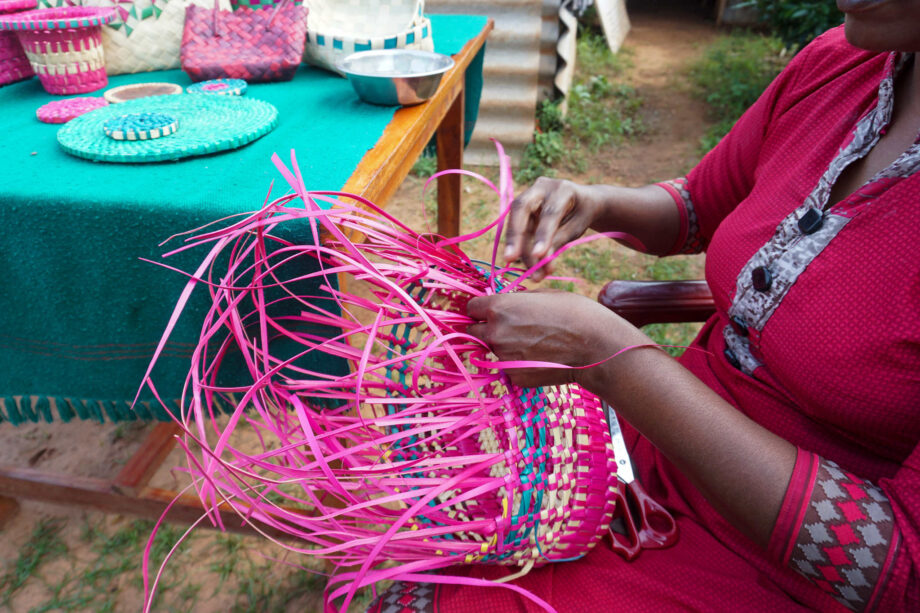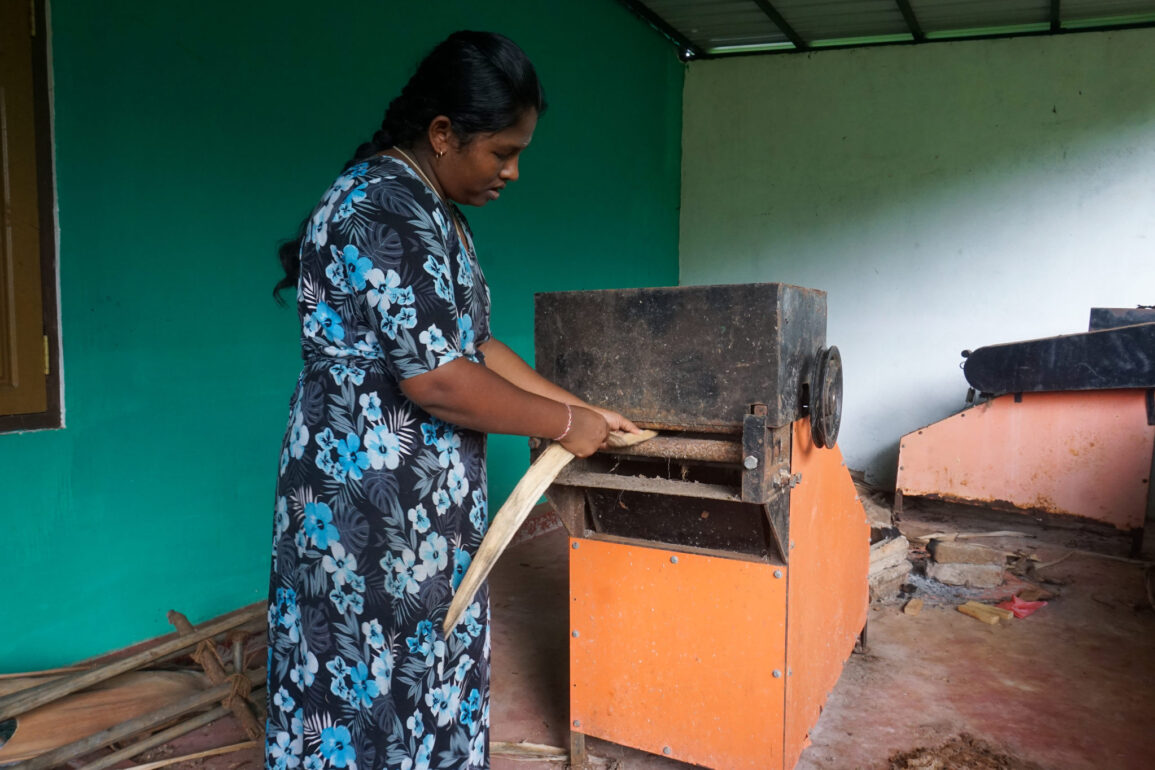KANNADDY, SRI LANKA — Four women are seated on the floor in a circle, their hands rapidly knitting dried banana fibers. In between is a small pile of finished goods: mats, sandals and baskets. Sobana Nishanthan is continuously interrupted by her phone as people call to place orders or invite her to participate in craft exhibitions. “I have participated in six exhibitions [recently] and there are six more this month,” she says. “I can’t go to all of them because I have sold out and it is difficult to get raw materials because of the rains.”
Nishanthan is a handicraft manufacturer who works with 10 women from her village to make tablecloths, baskets, bags and other decor and household items. They use the fibrous stems of banana plants to extract fibers, which are dried in the hot sun and processed. The raw material gets twisted like a rope or braided like hair to make household goods. Nishanthan sells the goods, which are in great demand by tourists; her monthly income tripled to 30,000 Sri Lankan rupees (96 United States dollars) in 2023. She shares 25% of her sales with her suppliers.
“I am very happy to earn more,” she says. “I can save a small amount after taking care of my family’s expenses. This profession gives me 100% confidence that no matter who fails me in this world, my work will never fail me.”
Other artisans in Kannaddy also say their sales have increased after years of slump due to the coronavirus pandemic and a domestic economic crisis that peaked in 2022, cutting people’s disposable incomes. The artisans credit the government with helping market their wares at exhibitions in Colombo, Jaffna and other crowded tourist centers. The government pays stall fees that can range from 30,000 to 50,000 rupees (about 96 to 160 dollars).



Nishanthan attended 10 exhibitions in 2022 and three times as many events in 2023, when she sold 900,000 rupees’ (2,751 dollars’) worth of products, exceeding 2022 profits.
Handicrafts have a long tradition in Sri Lanka. There were 2,832 artisans registered in 2019 with the National Crafts Council, the government agency dedicated to preserving and developing indigenous handicrafts. In the Tamil-speaking district of Vavuniya, 100 registered artisans — mostly women — make boxes, baskets, bags, decor, teacups and other items, according to the district secretariat. They use raw materials such as palm leaf, banana fiber, grass, clay, metal, coconut shells and cloth.
Handicrafts are an important source of employment and income for rural families, says Mary Delcia Antony Christian, an economist at the University of Jaffna. These products are attractive to international tourists, which brings foreign exchange into the country, she says.
Nishanthan began her business because she needed to support her family. Her parents left Sri Lanka in 1990 due to a bloody, decadeslong civil war that pitted the Liberation Tigers of Tamil Eelam in northern Sri Lanka against the majority Sinhalese government. Nishanthan was born and grew up in a refugee camp in India. When the war ended in 2009, the family emigrated back to their ancestral home in Kannaddy village in Vavuniya district.



Nishanthan completed high school in Vavuniya in 2015, but could not study further as her struggling family could not pay for her tuition. She began making and selling handicrafts using palm leaves and earned 5,000 rupees (15 dollars) a month. After five years, she switched to banana fiber goods, a craft she learned in India.
In 2017, she enrolled in a 12-day workshop run by the Industrial Development Board, the government organization responsible for the development of the country’s industrial sector. Five women from her village participated. After the workshop, she entered into an agreement with 10 women that she would market and sell their wares.
One of her manufacturers, Pirathap Jebatharsika, says that her monthly income doubled to 20,000 rupees (61 dollars) in 2023. She supplements the earnings of her husband, a daily laborer.
Pirathap’s family, too, moved to India as refugees in 2006 and returned after the war ended. She makes boxes, baskets, noodle-making plates, bags and garlands from palm leaves.


“I feel very satisfied and happy with this job,” she says. “Sales have increased due to exhibitions.”
When Sri Lanka’s economy crashed, this rural employment almost vanished. “The economic crisis period affected me a lot,” Nishanthan says. “I could not get the raw materials on time due to transport problems. The transport problem was because of lack of fuel.”
The government also had to stop training programs, says Sumithra Senthilkumaran, a women’s development officer at the Vengalacheddikulam Divisional Secretariat.
But the trainings and exhibitions have resumed since the end of 2022, she says. “Nowadays, exhibitions are organized by various government and nongovernmental organizations,” she adds. “Women can travel to different districts and participate in the exhibitions.”



Her department sponsored 15 exhibitions in 2023, she says. And in collaboration with the Sri Lankan government and UN Women, the United Nations entity in charge of gender equality, they selected 32 small-businesswomen from the Cheddikulam area for training on marketing.
Nishanthan says she intends to take her banana fiber handicraft collective to the next level by selling her wares online. She recently participated in a training workshop and plans to improve sales through social media. She also plans to register her business and employ the women who supply her. “I am fighting to take this business to the next level,” she says. “I am trying to give the women a monthly salary to support their livelihood.”
This post was originally published on this site be sure to check out more of their content








